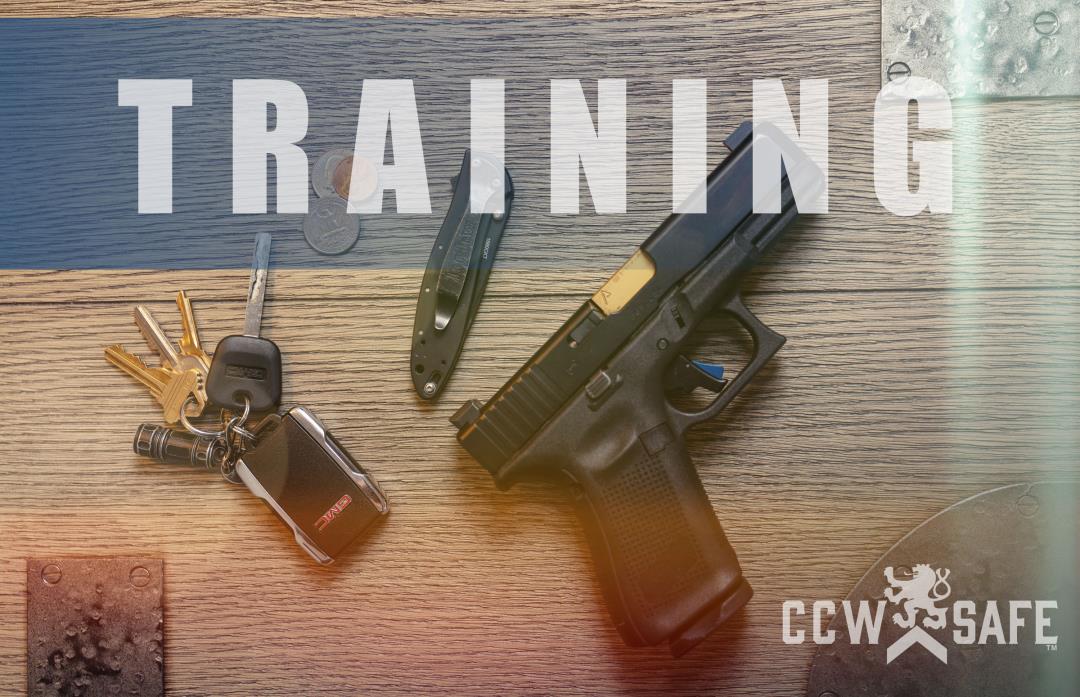
Posted on December 17, 2018 by support@ccwsafe.com in Training
The Four Principals of Concealed Carry Commitment- Part 3: Training
Part 3: TRAINING
In our series The Four Core Principles of Concealed Carriers, we’re exploring what I see as the most important principles concealed carriers should adopt to be safe and responsible as they exercise their right to carry. In this installment we will examine the importance of TRAINING and a personal example which made me chose it as a core principle.
Train to fight. Train to win. Fight like you train. FIGHT TO WIN.
The goal of every armed encounter is to survive alive. Alive is a WIN. Battered, beaten and bloody but alive is a WIN. The other option is unthinkable. And permanent. I stated earlier that the premise for carrying concealed is to use the weapon to eliminate an immediate deadly threat to yourself or others.
I can’t tell you how many times I have spoken with people who haven’t been to the range since they got their permit. Dozens, at least. How many times have I asked, “what do you carry?”, only to have the response “uh, you know, that cute little gun with the pretty wooden handle thingies. Wanna see it?”
By now, you have read my story about the murder of Deputy George Pfeil, and how it changed my personal and professional perspective. I spoke about how my mindset had to change and how I directed myself toward becoming educated to be a better deputy sheriff. Along with that came a new commitment to training. I became more interested in becoming a better shooter, and joined the agency’s Combat Pistol team. The team held shooting meets with other area law enforcement agencies, but unlike those other agencies that used match grade weapons and fast draw competition holsters, we used strictly our service weapons and duty holsters. The idea was that if we used the same weapon and leather in competition that we carried on duty every day, there would be no drop off or change of muscle memory between competition and real life situations. That was, in retrospect, an awesome decision by our range master and coach.
As time went by, I competed for and joined SWAT, and eventually became a law enforcement firearms instructor. I value every lesson and opportunity I have ever had to improve my skills, and look for other innovations for improving skills for myself and the officers I train.
Train to fight. You have made the COMMITMENT to carry concealed. You have developed the mindset. You have educated yourself about the law, the weapon or types you are comfortable with. You chose or are choosing a weapon. Range time is next. COMMIT to training. COMMIT to spending the time necessary to achieve and maintain a skill level that will support your COMMITMENT.
Train to fight. While you are at the range, don’t just punch holes in a paper target. Anyone can do that. If allowable, use the holster, purse or fanny pack you carry concealed in, and draw and fire from that. Get comfortable with close-in shots. Learn to fire from a close-quarters position, not fully extended. Work in semi- and full darkness if allowable. Speak with your range operator about one-on-one time in a darkened environment. Many ranges only allow full light level and no combat-style drawing for obvious safety and insurance liability reasons.
Train to fight. An option for you is to practice at home. ALWAYS PRACTICE SAFE HANDLING TECHNIQUES AND FOLLOW THE RULES. Ensure your weapon is unloaded and move to a separate room from your ammunition if necessary, and practice drawing and engaging an imaginary target. Large mirrors are good to observe yourself.
Train to fight. Develop muscle memory by repetition. Work in front of that mirror daily. Pick a fifteen- minute period every day that you can develop your skill in getting to and producing your weapon for action. Do that for as long as it takes to feel comfortable and competent. You can reduce your daily training to ten, then to five minutes. If you do it daily, you develop a muscle memory for drawing and working from your preferred concealed carry mode. When you are comfortable with working in lighted conditions, try doing it in the dark. Make sure you can find the weapon in pitch darkness. Make your preferred carry method one that works in both full light and complete darkness.
Train to fight. Athletes and professionals use the concept of muscle memory to ensure a consistent outcome each time they do something. Whether it’s shooting a free throw in the NBA or drawing a handgun from a concealed location, the repetitive actions done over days, months and years makes the difference. An NBA player has made free throws since he was 8. No different than actually firing the weapon, drawing the weapon safely and smoothly is a muscle memory “thing”. The weapon is no good to you if you can’t draw and bring it to bear.
Train to fight. If you have a range near you that has a computerized “Shoot/Don’t Shoot” decision-making simulator, spend some time and money there on a regular basis. Let them put you through a variety of scenarios designed to force you to make stressed decisions. This is great training and allows you to see how you respond under adverse situations.
Train to fight. Be comfortable with how you carry. We discussed this somewhat in the EDUCATION section, but there’s a carryover to TRANING also. If something is “not right”, try alternatives. Concealed carry should not be about being concerned with where the weapon is all the time. It should feel comfortable and natural. You should find the place on you or near you that is “right” for you and work from there. Find what works for you, and don’t rely on someone else’s comfort zone to be yours. Be flexible, be open minded and be yourself.
Train to fight. Almost every day for over forty years, I have carried a handgun. When I wasn’t actually wearing it, it was generally close by. There are days when I don’t actually manipulate it in the sense that I draw and inspect it, but those days are rare. Typically, even after all these years, at least five times a week, I un-holster, unload, safety check, double check and manipulate my handgun in a safe environment. I make sure I am competent with it. I also check my holster and know where that weapon is at all times and how I am going to carry it when I leave my house. I never allow my years of experience to interfere with the safety and repetition that is needed to maintain my competence. You shouldn’t either.
Train to fight. If you train to fight, you will fight to win.
Remember, the concealed carry COMMITMENT is a pledge to yourself and to those around you that should revolve around these four core elements. In our next instalment we’ll examine the final element is JUDGEMENT and why it is important for concealed carriers to adopt and prepare themselves for the worst-case scenario.
 |
Bob O’ConnorBob O’Connor is a highly experienced criminal investigator, and has had the opportunity to be involved at both the investigator and major case supervisory/management roles in multiple high profile, media-intensive investigations during his career. Those cases and the various assignments over a 40 year career provide Bob with a unique perspective of the criminal justice system and the interaction between the police and the public. He has worked at the local, county, state and federal levels successfully, using multiagency cooperation as the basis for mutual accomplishments. Retired FDLE Special Agent Supervisor |